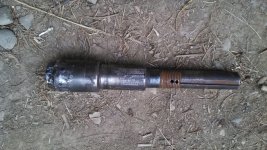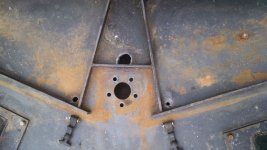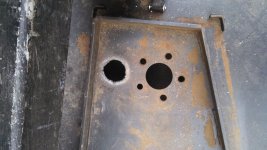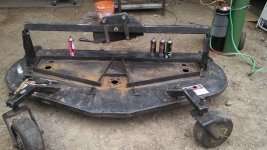woodlandfarms
Super Member
- Joined
- Jul 31, 2006
- Messages
- 6,137
- Location
- Los Angeles / SW Washington
- Tractor
- PowerTrac 1850, Kubota RTV x900
So I will start this thread, and I am sure lots of people are going to have their own versions of fixes.
First, my machine is 1850 with a 96" three head rough cut mower. I break off 6 to 10 blades a year. One major modification is that I run with 1/2" blades instead of 1/4 or 3/8" blades.
The design of my 1850 is relatively simple. Bolts with washers hold blades (with bushings in the blades for reduced wear). The hub itself I have no idea on the source, it appears to be custom made. The bottom plate onf the hub has 4 holes. On the other side of the holes are regular 5/8" nuts, tack welded in 3 spots. The hub itself has been tapped (meaning that the metal plate, the threads continue through to the nuts that hold the blade). The hub has a trailer wheel shaft that goes up through the bearing block to the pulleys. the bearing block is a simple trailer axel bearing block, and is bolted to the deck of the mower. above that is a nut that hold the whole thing together, followed by a pulley (and in the center a love joy). None of this is well designed IMO, but to hold costs down, probably the best choice.
OK, the point of my note was to review my methods of bolt extraction.
So setup. I am at the point where I just lift the mower up, do my work off the arm and put it down. If I run into trouble I will flip the mower over which is kind a magilla but having the mower upside down makes it so much easier.
Let me work backwards from where I am at now to the start.
I have gone ahead and cut 3 holes around 3" in size over top of the mower deck where the spindles are. Measure carefully, and consider things that will be in your way. This does allow more water into the mower deck if you let your mower sit out like I do. It also allows debris in.
I then purchase longer 5/8 Bolts to hold my blades on, so they poke through the nut further. I use Grade 5, they have a bit of a shoulder on them so be careful if you go this route. I then made a custom tool, I got a long 5/8 bolt and welded on a nut part way threaded onto the bolt. This is my "Driver". So I break a bolt. Instead of trying to extract it, I thread this bolt onto the broken bolt trought the hole in the mower deck and use my impact driver to drive it down. It won't go very far but at least with a 1/4" hanging out, I can get Vice Grips on the bolt and work it free. now I have had the misfortune of once not getting the driver tool properly threaded onto the broke bolt. I was going to fast trying to get back to mowing. I hit it with the impact wrench, went to the other side with the vice grips and now it is stuck. Stuck in both directions cause the other side was bunged up by my driver, and now the blade side was bunged up by my vise grips. This caused a complete tear down.
Now I only recently (in the passed 4 years) did this method. Prior to it I did as follows.
Remove the hub and cut out the nut. Royal PITA. But self explanatory. When you put in a new nut it is a bit truck as the hub is threaded so make sure you don't over tighten the nut to the bolt before you weld (It creates a bit of a lock).
Drill and use an easy out - Results were never very good. You really need a mag drill. But I woud drill, but a tap in, work it out enough to get vice grips on it. Really a PITA with grade 5 and impossible with grade 8.
Score with a Saw. So I would take a 4" angle and try to score the head of the bolt enough to get purchase, best case with a screw driver. Generally what I would do is get is score the broken head enough to use a punch and tap the bolt in the proper direction to unscrew it (not sure if this method makes sense or not).
Examine the break Sometimes I would get lucky and the bolt wouldbreak in such a way that there was a "tab" of metal I could use my metal punch on to drive the bolt out.
Weld on a nut - this became my favorite method prior to the holes being cut, but given my welding skills I had to flip the mower over. I would take another 5/8 or 1/2 inch nut and put it over top of the broken bolt. I would then grab my stick welder and put a ton of heat down in the center of the nut onto the bolt and fill the weld up. Then put a wrench on it (Impacts tend to tear the welded nut off but then again I am a terrible welder). This heat would also help break the bolt free. But it was not drama free. Many times my welding skill let me down and I would not penetrate the bolt below, or I would melt the nut and then not be able to use my wrench or driver.
Lubricants, Waxes and Torches. So heat is your friend, but remember you have to heat through the hub to the nut on the other side. So getting the hub glowing hot doesn't always get the nut hot. You can spray with lubricants, but you need to make sure you still have a way to get them out. Letting stuff soak is the key, like overnight at least. Waxes are sort of an old farmers trick. You heat with a torch then apply some candle wax. Wax will go down really far and break up the rust. None of this stuff works well for me, but heat is an important. Even if you do not have a oxy set, a simple plumbers MAP gas copper welding rig will be fine.
Think that covers it. Wish I was home would provide pictures (will look to see if I have any anyway).
First, my machine is 1850 with a 96" three head rough cut mower. I break off 6 to 10 blades a year. One major modification is that I run with 1/2" blades instead of 1/4 or 3/8" blades.
The design of my 1850 is relatively simple. Bolts with washers hold blades (with bushings in the blades for reduced wear). The hub itself I have no idea on the source, it appears to be custom made. The bottom plate onf the hub has 4 holes. On the other side of the holes are regular 5/8" nuts, tack welded in 3 spots. The hub itself has been tapped (meaning that the metal plate, the threads continue through to the nuts that hold the blade). The hub has a trailer wheel shaft that goes up through the bearing block to the pulleys. the bearing block is a simple trailer axel bearing block, and is bolted to the deck of the mower. above that is a nut that hold the whole thing together, followed by a pulley (and in the center a love joy). None of this is well designed IMO, but to hold costs down, probably the best choice.
OK, the point of my note was to review my methods of bolt extraction.
So setup. I am at the point where I just lift the mower up, do my work off the arm and put it down. If I run into trouble I will flip the mower over which is kind a magilla but having the mower upside down makes it so much easier.
Let me work backwards from where I am at now to the start.
I have gone ahead and cut 3 holes around 3" in size over top of the mower deck where the spindles are. Measure carefully, and consider things that will be in your way. This does allow more water into the mower deck if you let your mower sit out like I do. It also allows debris in.
I then purchase longer 5/8 Bolts to hold my blades on, so they poke through the nut further. I use Grade 5, they have a bit of a shoulder on them so be careful if you go this route. I then made a custom tool, I got a long 5/8 bolt and welded on a nut part way threaded onto the bolt. This is my "Driver". So I break a bolt. Instead of trying to extract it, I thread this bolt onto the broken bolt trought the hole in the mower deck and use my impact driver to drive it down. It won't go very far but at least with a 1/4" hanging out, I can get Vice Grips on the bolt and work it free. now I have had the misfortune of once not getting the driver tool properly threaded onto the broke bolt. I was going to fast trying to get back to mowing. I hit it with the impact wrench, went to the other side with the vice grips and now it is stuck. Stuck in both directions cause the other side was bunged up by my driver, and now the blade side was bunged up by my vise grips. This caused a complete tear down.
Now I only recently (in the passed 4 years) did this method. Prior to it I did as follows.
Remove the hub and cut out the nut. Royal PITA. But self explanatory. When you put in a new nut it is a bit truck as the hub is threaded so make sure you don't over tighten the nut to the bolt before you weld (It creates a bit of a lock).
Drill and use an easy out - Results were never very good. You really need a mag drill. But I woud drill, but a tap in, work it out enough to get vice grips on it. Really a PITA with grade 5 and impossible with grade 8.
Score with a Saw. So I would take a 4" angle and try to score the head of the bolt enough to get purchase, best case with a screw driver. Generally what I would do is get is score the broken head enough to use a punch and tap the bolt in the proper direction to unscrew it (not sure if this method makes sense or not).
Examine the break Sometimes I would get lucky and the bolt wouldbreak in such a way that there was a "tab" of metal I could use my metal punch on to drive the bolt out.
Weld on a nut - this became my favorite method prior to the holes being cut, but given my welding skills I had to flip the mower over. I would take another 5/8 or 1/2 inch nut and put it over top of the broken bolt. I would then grab my stick welder and put a ton of heat down in the center of the nut onto the bolt and fill the weld up. Then put a wrench on it (Impacts tend to tear the welded nut off but then again I am a terrible welder). This heat would also help break the bolt free. But it was not drama free. Many times my welding skill let me down and I would not penetrate the bolt below, or I would melt the nut and then not be able to use my wrench or driver.
Lubricants, Waxes and Torches. So heat is your friend, but remember you have to heat through the hub to the nut on the other side. So getting the hub glowing hot doesn't always get the nut hot. You can spray with lubricants, but you need to make sure you still have a way to get them out. Letting stuff soak is the key, like overnight at least. Waxes are sort of an old farmers trick. You heat with a torch then apply some candle wax. Wax will go down really far and break up the rust. None of this stuff works well for me, but heat is an important. Even if you do not have a oxy set, a simple plumbers MAP gas copper welding rig will be fine.
Think that covers it. Wish I was home would provide pictures (will look to see if I have any anyway).





